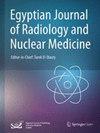Hypertrophic olivary degeneration following head injury: a case report
IF 0.5
Q4 RADIOLOGY, NUCLEAR MEDICINE & MEDICAL IMAGING
Egyptian Journal of Radiology and Nuclear Medicine
Pub Date : 2024-06-17
DOI:10.1186/s43055-024-01292-1
引用次数: 0
Abstract
Hypertrophic olivary degeneration (HOD) is a unique type of neuronal degeneration presenting as hypertrophy, in contrast to atrophy as seen in most cases. It presents with classical characteristic clinical features due to involvement of dentate-rubral-olivary pathway, also described as triangle of Guillain and Mollaret formed in midbrain, pons and cerebellum. It can be idiopathic or secondary to infarction, bleeding, tumours, trauma or demyelination. However, the mechanism is still unclear. Herein, we present a case of HOD that had developed after post-traumatic pontine and midbrain haemorrhagic contusion. A young male patient presented with progressively increasing tremors of both hands, inability to walk and multiple cranial nerve palsy. Magnetic resonance imaging demonstrated bilateral inferior olivary nucleus enlargement and signal changes seen as T2 and T2-FLAIR hyperintensities and non-enhancing T1 iso-intensities. Based on these features, diagnosis of HOD was made. Patient was kept on conservative management and his condition improved. Hypertrophic olivary degeneration is a unique neuronal degeneration with typical clinical manifestations and distinct imaging features. Proper and early recognition and multidisciplinary treatment approach can result in the best outcomes for the patient.头部受伤后的肥大性橄榄变性:病例报告
肥大性橄榄核变性(HOD)是一种独特的神经元变性类型,表现为肥大,与大多数病例中的萎缩不同。它具有典型的特征性临床表现,是由于中脑、脑桥和小脑中的齿状突起-眶-橄榄通路受累所致,也被描述为吉兰三角区和莫拉雷三角区。它可能是特发性的,也可能继发于梗塞、出血、肿瘤、外伤或脱髓鞘。然而,其发病机制仍不清楚。在此,我们介绍了一例因外伤后桥脑和中脑出血挫伤而导致的 HOD 病例。患者为一名年轻男性,双手震颤逐渐加重,无法行走,并伴有多发性颅神经麻痹。磁共振成像显示双侧下橄榄核增大,信号改变为T2和T2-FLAIR高密度和非增强T1等密度。根据这些特征,诊断为 HOD。患者接受了保守治疗,病情有所好转。肥厚性橄榄变性是一种独特的神经元变性,具有典型的临床表现和明显的影像学特征。正确的早期识别和多学科治疗方法可为患者带来最佳疗效。
本文章由计算机程序翻译,如有差异,请以英文原文为准。
求助全文
约1分钟内获得全文
求助全文
来源期刊

Egyptian Journal of Radiology and Nuclear Medicine
Medicine-Radiology, Nuclear Medicine and Imaging
CiteScore
1.70
自引率
10.00%
发文量
233
审稿时长
27 weeks
 求助内容:
求助内容: 应助结果提醒方式:
应助结果提醒方式:


